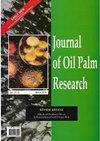EVALUATION OF OIL PALM FROND FOR BIOBUTANOL PRODUCTION BY DIFFERENT Clostridia SPECIES
IF 1.3
4区 农林科学
Q2 Agricultural and Biological Sciences
引用次数: 0
Abstract
Ideal substrates and biobutanol producers are the key and most important ingredients for efficient biobutanol production. In this research, we evaluated the composition of oil palm fronds based on the different ages of the plant. Fresh oil palm frond (OPF) juice was found to be the most potent OPF component for biobutanol production and was pressed from 5, 10, 15 and 20 yr old trees using a sugarcane pressing machine. The total sugar concentrations were estimated by the use of a DNS and spectrophotometer and were found to be decreasing with the increasing age of the palm oil tree, with the highest sugar obtained at OPF ages 5 and 10. HPLC analysis revealed that glucose was the highest fraction in the juice, accounting for 57% to 66%, while fructose (12%-17%) and sucrose (19%-25%) made up the remaining percentage. Fermentation inhibitors like gallic and ferulic acids were also detected in the juice using the HPLC technique, and their concentrations also increased with age. Therefore, the research screened for a robust bacterial strain that can tolerate these phenolics in the hydrolysate for biobutanol production. Out of the 11 strains of Clostridium screened, strain A1 was found to successfully utilise the hydrolysate and yield the highest concentration of biobutanol at 2.32 g/L with productivity of 0.064 g/L/hr. The strain was identified as Clostridium strain A1 based on 16S rRNA gene sequencing techniques.不同梭菌在油棕叶生产生物丁醇的评价
理想的底物和生物丁醇生产者是高效生产生物丁醇的关键和最重要的组成部分。在本研究中,我们根据植物的不同年龄对油棕叶子的成分进行了评价。新鲜油棕叶(OPF)果汁被发现是生产生物丁醇最有效的OPF成分,使用甘蔗压榨机从5年,10年,15年和20年的树中压榨。使用DNS和分光光度计估计总糖浓度,发现随着树龄的增加而降低,在OPF年龄5和10时获得最高糖。HPLC分析表明,葡萄糖是果汁中含量最高的部分,占57% ~ 66%,其余部分为果糖(12% ~ 17%)和蔗糖(19% ~ 25%)。利用高效液相色谱法还检测到了发酵抑制剂没食子酸和阿魏酸,其浓度也随着年龄的增长而增加。因此,该研究筛选了一种健壮的细菌菌株,可以耐受水解物中的这些酚类物质,用于生产生物丁醇。在筛选的11株梭状芽胞杆菌中,菌株A1成功地利用了水解产物,产生物丁醇浓度最高,为2.32 g/L,产率为0.064 g/L/hr。通过16S rRNA基因测序技术鉴定菌株为A1梭菌。
本文章由计算机程序翻译,如有差异,请以英文原文为准。
求助全文
约1分钟内获得全文
求助全文
来源期刊

Journal of Oil Palm Research
农林科学-食品科技
CiteScore
2.60
自引率
30.80%
发文量
69
审稿时长
>12 weeks
期刊介绍:
JOURNAL OF OIL PALM RESEARCH, an international refereed journal, carries full-length original research papers and scientific review papers on various aspects of oil palm and palm oil and other palms. It also publishes short communications, letters to editor and reviews of relevant books. JOURNAL OF OIL PALM RESEARCH is published four times per year, i.e. March, June, September and December.
 求助内容:
求助内容: 应助结果提醒方式:
应助结果提醒方式:


